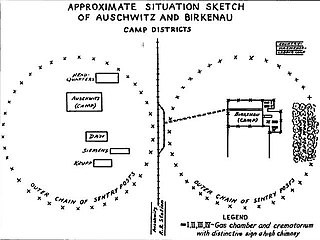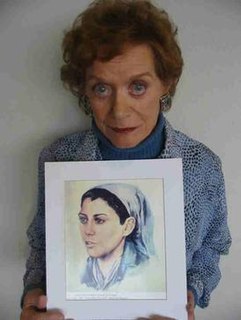Felka Platek | |
|---|---|
 Felka Platek, 1937 | |
| Born | 3 November 1899 Warsaw, Poland |
| Died | 2 August 1944 (aged 44) Auschwitz-Birkenau, Poland |
| Nationality | Polish |
| Known for | Painting |
Felka Platek (Felka Płatek) (1899-1944) was a Polish artist.
Felka Platek | |
|---|---|
 Felka Platek, 1937 | |
| Born | 3 November 1899 Warsaw, Poland |
| Died | 2 August 1944 (aged 44) Auschwitz-Birkenau, Poland |
| Nationality | Polish |
| Known for | Painting |
Felka Platek (Felka Płatek) (1899-1944) was a Polish artist.
Platek was born on 3 November 1899 in Warsaw, Poland. [1] She was the companion and later the wife of the German painter Felix Nussbaum. [2]
The couple fled Germany around 1935. They lived in Paris, then Ostend, settling in Brussels where they married in 1937. [3] Nussbaum and Platek were arrested by the Germans in 1944. They were sent to the Auschwitz concentration camp
Platek was murdered, probably on or about 2 August 1944 at Auschwitz. [4]
In 2014 the International Auschwitz Committee sponsored a program entitled "Find Felka! Find Felix!". The Felix Nussbaum Haus in Osnabrück includes a permanent display of Platek's work. " [5]

The Auschwitz concentration camp was a complex of over 40 concentration and extermination camps operated by Nazi Germany in occupied Poland during World War II and the Holocaust. It consisted of Auschwitz I, the main camp (Stammlager) in Oświęcim; Auschwitz II-Birkenau, a concentration and extermination camp with gas chambers; Auschwitz III-Monowitz, a labor camp for the chemical conglomerate IG Farben; and dozens of subcamps. The camps became a major site of the Nazis' Final Solution to the Jewish Question.

Majdanek was a Nazi concentration and extermination camp built and operated by the SS on the outskirts of the city of Lublin during the German occupation of Poland in World War II. It had seven gas chambers, two wooden gallows, and some 227 structures in all, placing it among the largest of Nazi-run concentration camps. Although initially intended for forced labor rather than extermination, the camp was used to kill people on an industrial scale during Operation Reinhard, the German plan to murder all Jews within their own General Government territory of Poland. The camp, which operated from October 1, 1941, until July 22, 1944, was captured nearly intact, because the rapid advance of the Soviet Red Army during Operation Bagration prevented the SS from destroying most of its infrastructure, and the inept Deputy Camp Commandant Anton Thernes failed in his task of removing incriminating evidence of war crimes.

Pruszków(listen) is a city in central Poland, situated in the Masovian Voivodeship since 1999. It was previously in Warszawa Voivodeship (1975–1998). Pruszków is the capital of Pruszków County, located along the western edge of the Warsaw urban area. The town's population has grown significantly, from 16,000 in the early part of the 20th century to 60,068 in the 2014 census by the Central Statistical Office of Poland.
A Holocaust memorial day or Holocaust remembrance day is an annual observance to commemorate the victims of the Holocaust, the genocide of six million European Jews by Nazi Germany. Many countries, primarily in Europe, have designated national dates of commemoration. In 2005, the United Nations instituted an international observance, International Holocaust Remembrance Day.

Felix Nussbaum was a German-Jewish surrealist painter. Nussbaum’s work gives a rare glimpse into the essence of one person among the victims of the Holocaust.

Josef Kramer was the Commandant of Auschwitz-Birkenau and of the Bergen-Belsen concentration camp. Dubbed the Beast of Belsen by camp inmates, he was a German Nazi war criminal, directly responsible for the deaths of thousands of people. He was detained by the British Army after the Second World War, convicted of war crimes and hanged on the gallows in the prison at Hamelin by British executioner Albert Pierrepoint.
Events from the year 1943 in art.
Events from the year 1944 in art.

The Vrba–Wetzler report is one of three documents that comprise what is known as the Auschwitz Protocols, otherwise known as the Auschwitz Report or the Auschwitz notebook. It is a 33-page eye-witness account of the Auschwitz concentration camp in German-occupied Poland during the Holocaust.

Rudolf "Rudi" Vrba was a Slovak-Jewish biochemist who, as a teenager in 1942, was deported to the Auschwitz concentration camp in German-occupied Poland. He became known for having escaped from the camp in April 1944, at the height of the Holocaust, and for having co-written a detailed report about the mass murder that was taking place there. Distribution of the report by George Mantello in Switzerland is credited with having halted the mass deportation of Hungary's Jews to Auschwitz in July 1944, saving more than 200,000 lives. After the war Vrba trained as a biochemist, working mostly in England and Canada.
Kitty Hart-Moxon, OBE is a Polish-English Holocaust survivor. She was sent to the Auschwitz-Birkenau death camp in 1943 at age 16, where she survived for two years, and was also imprisoned at other camps. Shortly after her liberation in April 1945 by American soldiers, she moved to England with her mother, where she married and dedicated her life to raising awareness of the Holocaust. She has written two autobiographies entitled I am Alive (1961) and Return to Auschwitz (1981).

The issue of why the Allies did not act on early reports of atrocities in the Auschwitz concentration camp by destroying it or its railways by air during World War II has been a subject of controversy since the late 1970s. Brought to public attention by a 1978 article from historian David Wyman, it has been descried by Michael Berenbaum as "a moral question emblematic of the Allied response to the plight of the Jews during the Holocaust", and whether or not the Allies had the requisite knowledge and the technical capability to act continues to be explored by historians. The U.S. government followed the military's strong advice to always keep the defeat of Germany the paramount objective, and refused to tolerate outside civilian advice regarding alternative military operations. No major American Jewish organizations recommended bombing.

Annemarie Dina Babbitt was an artist and Holocaust survivor. A naturalized U.S. citizen, she resided in Santa Cruz, California.

Holocaust trains were railway transports run by the Deutsche Reichsbahn national railway system under the control of Nazi Germany and its allies, for the purpose of forcible deportation of the Jews, as well as other victims of the Holocaust, to the Nazi concentration, forced labour, and extermination camps.

The 108 Martyrs of World War II, known also as the 108 Blessed Polish Martyrs, were Roman Catholics from Poland killed during World War II by Nazi Germany.
Art and Remembrance: The Legacy of Felix Nussbaum is a 1993 documentary directed by Barbara Pfeffer, which explores the life of Jewish artist, Felix Nussbaum.
Jan Baraś-Komski was a Polish painter. He studied painting, anatomy, and art history at the Kraków Academy of Fine Arts.

Laureen Nussbaum is a German-born American scholar and writer. She is best known for being a Holocaust survivor, and as a scholar and childhood friend of the famed memoirist Anne Frank. Nussbaum is frequently consulted on Anne Frank works and literature.

The Holocaust in Hungary was the final act of mass murder of a Jewish community by Nazi Germany during the 1941–1945 genocide of the European Jews. New restrictions against Jews were imposed soon after Germany occupied Hungary on 19 March 1944. The invading troops included a Sonderkommando led by SS officer Adolf Eichmann, who arrived in Budapest to supervise the deportation of the country's Jews to the Auschwitz concentration camp in occupied Poland. Between 15 May and 9 July 1944, over 434,000 Jews were deported on 147 trains, most of them to Auschwitz, where about 80 percent were gassed on arrival.